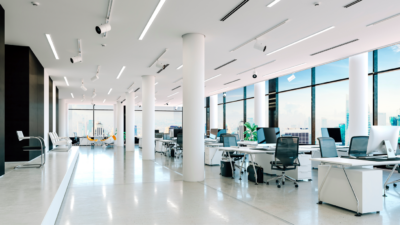Discussion of construction activity has taken something of a back seat during the U.S. office sector’s pandemic-driven downturn, with net absorption and sublease space dominating the headlines. Over the past four quarters, net absorption totaled an unprecedented negative 139.6 million square feet and sublease space rose by over 60% to a record 202.2 million square feet, pushing the national office vacancy rate up by 250 basis points to 14.2%.
Although some projects have been put on hold while developers await greater market clarity, development activity remains significant. In addition to the 65.5 million square feet of new space completed over the past four quarters, there is still 146.5 million square feet of office construction underway across the U.S. While this is down from the current cycle’s peak of 164.3 million square feet seen in Q3 2020, it is elevated by historic standards and comfortably above the previous cyclical peak of 125.2 million square feet in Q2 2008.

Where is this activity taking place? Out of the 146.5 million square currently underway, 75.7 million square feet is in CBD markets with 70.8 million square feet in the suburbs. However, when measured as a share of inventory, office construction is more heavily weighted toward CBD markets, where it represents 3.7% of existing stock compared with 1.6% in the suburbs. The overall national share is 2.3%.
Manhattan has by far the greatest amount of office space being built in a single market at 23.8 million square feet, followed by the San Francisco Bay Area at 13.8 million square feet, the larger share of which is taking place in Silicon Valley. There are an additional eight markets with more than five million square feet of office space under construction, led by Washington D.C. (9.0 million square feet), Austin (7.8 million square feet), and Atlanta (7.1 million square feet).
However, Austin has the greatest exposure to new construction with space underway equivalent to 13% of inventory, followed by the Bay Area at 6.7% and Charlotte at 6.3%. There are six more markets where construction exposure is above the national average, led by Manhattan (4.4%) and Seattle (4.3%).
While these numbers help to highlight possible supply-side risks, a good share of this space is preleased. A more telling statistic is the amount of space underway that has yet to lease. To understand this dynamic, we analyzed construction levels and preleasing activity across the top 25 U.S. office markets.
The good news is that a healthy proportion of space being built already has future tenants in place. Out of the 121.3 million square feet of office space under construction across the top 25 markets, 57.8 million square feet (47.8% of total) is preleased. In addition, there are eight markets where over 60% of space underway is preleased, led by Philadelphia (81%), Washington D.C. (70.9%), and Orange County (67.4%).
Looking at the two markets that dominate overall construction activity, preleasing stands at 40.6% in Manhattan and 53.4% in the Bay Area. There is a notable bifurcation in the latter market, with preleasing at 70.6% in Silicon Valley, but only 25.4% in San Francisco. Other markets with low levels of preleasing include San Diego (21.8%), Los Angeles (34.3%), and Chicago (35.5%).

How will this play out? While there will be variations at both a market and submarket level, overall supply-side risk does not appear excessive. As preleased projects deliver and tenants relocate to their new premises, the net effect on vacancy levels should be relatively modest. However, some downsizing could take place as firms move into more efficient premises.
Space underway that remains unleased equates to around 1% of total office market inventory. In addition, some of the projects that make up this total have had their timing moved out as developers reassess the best time to bring them to market.
Although construction levels are elevated, activity is slowing. This is expected to continue through the remainder of this year and next. While selected projects will continue to break ground where there are perceived opportunities, speculative construction should be limited until there are clear signs of sustainable recovery in the office sector.

 U.S. National Research
U.S. National Research
 Marianne Skorupski
Marianne Skorupski Michael Lirtzman
Michael Lirtzman Kevin Gonzalez
Kevin Gonzalez Kim Kendall
Kim Kendall Ashley Harrison
Ashley Harrison
 Charles Dilks
Charles Dilks Matthew Johnston
Matthew Johnston Victoria Abbasi
Victoria Abbasi
 Derek Daniels
Derek Daniels Franklin Wallach
Franklin Wallach